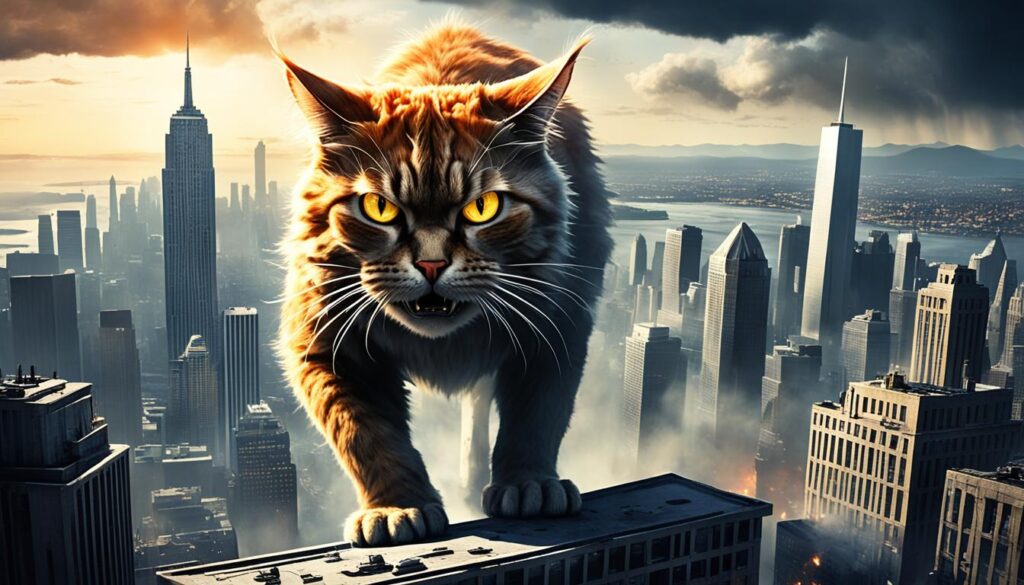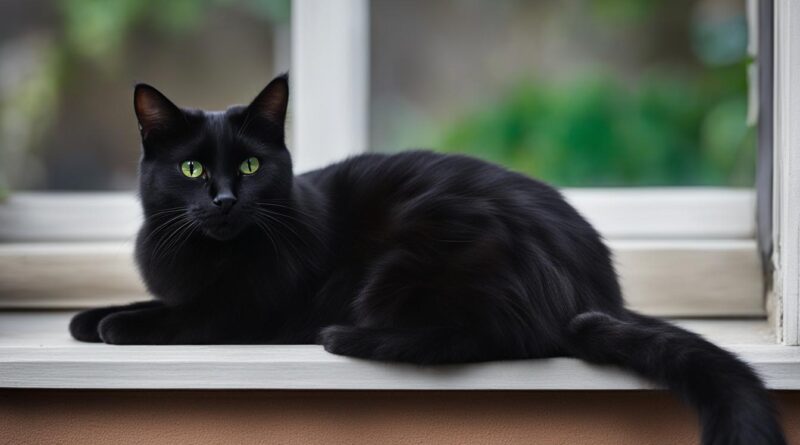A Monster in Cats Clothing: Feline Facts Unveiled
Prepare to be startled by a hidden danger lurking in the ordinary world of cats. Beneath their adorable facade lies an alarming creature, capable of disguising itself as our beloved feline friends. But don’t be fooled by their innocent appearance – this cat creature is a deceptive monster in disguise, waiting to pounce when least expected.
Known by many names – the cat monster, the disguised danger, the hidden monster – this feline imposter has mastered the art of deception. With its cunning, it conceals its true nature, blending seamlessly into our lives, and often going unnoticed until it’s too late. But fear not, for we have delved deep into the fascinating world of this feline disguise to unveil its secrets.
Key Takeaways:
- Beware of the deceptive appearance of seemingly innocent cats.
- Unveiling the hidden monster within these feline creatures is essential.
- Stay alert and look beyond their charming exterior.
- Discover the astonishing truth behind their deceptive nature.
- Learn how to protect yourself from the disguised danger.
The Necessity of Extreme Scare Tactics
In medieval Iceland, the tradition of giving new clothes for Christmas was deeply ingrained in the culture. The harsh Nordic winter required meticulous preparation, and anyone who didn’t complete their work on time would be excluded from receiving new clothes. The threat of the Yule Cat served as an extreme scare tactic to ensure that everyone worked diligently. This punishment was seen as necessary to protect the community and uphold the importance of timely Christmas preparations.
“The Yule Cat’s legend played a crucial role in motivating the villagers to complete their Christmas preparations on time,” explains Ólafur Þórðarson, a historian specializing in Icelandic folklore. “The fear of being excluded from receiving new clothes created a punitive incentive structure that forced everyone to prioritize their tasks and work diligently, even in the face of the challenging Icelandic winter.”
In Icelandic society, where survival was closely tied to careful planning and preparedness, extreme scare tactics like that of the Yule Cat were deemed necessary to ensure the community’s well-being. The threat of exclusion from receiving new clothes served as a powerful motivator for individuals to complete their tasks and contribute to the collective effort of Christmas preparations.
The Icelandic Winter and the Importance of Preparedness
The Icelandic winter is known for its extreme conditions, with harsh weather and limited daylight hours. This made thorough Christmas preparations crucial for the survival of communities. The long and dark winter months posed significant challenges, and failure to complete tasks in a timely manner could have severe consequences.
According to historical records, the tradition of giving new clothes for Christmas emerged as a way to ensure that individuals had adequate protection against the harsh winter weather. New clothes were often made from warm, durable materials and were seen as essential for staying safe and comfortable during the long Icelandic winter.
As Þórðarson explains, “In a time when clothing was handmade and resources were limited, receiving new clothes was a significant event. It symbolized the readiness for winter and the ability to withstand the challenges that lay ahead.”
The Punitive Incentive Structure of the Yule Cat Legend
The Yule Cat’s legend played a central role in shaping Icelandic Christmas traditions and reinforcing the importance of completing tasks on time. The fear of being excluded from receiving new clothes was a powerful motivator that drove individuals to work diligently and ensure the timely completion of Christmas preparations.
In a society where the punishment of exclusion from new clothes was seen as a harsh and significant consequence, the Yule Cat served as a representation of the potential risks and consequences of procrastination and laziness.
“The Yule Cat represented a punitive incentive structure that provided a clear motivation for individuals to prioritize their tasks and contribute to the collective effort of Christmas preparations,” says Þórðarson.
This extreme scare tactic was leveraged to uphold the cohesive nature of Icelandic society, where communal survival was paramount. The Yule Cat, with its menacing presence, reminded individuals of the importance of collective responsibility and the dire consequences of failing to fulfill their obligations.
| Advantages of Extreme Scare Tactics | Disadvantages of Extreme Scare Tactics |
|---|---|
|
|
The Choice of a Cat as the Beast of Terror
One may wonder why a cat was chosen as the embodiment of terror in the legend of the Yule Cat. The answer lies in the influence of Viking culture and the surrounding pagan beliefs prevalent in the Nordic countries.
The Vikings, known for their seafaring prowess, recognized the value of cats in controlling the vermin that plagued their long voyages. These felines became an essential part of their entourage, earning their place as trusted companions. As the Viking influence spread, so did the popularity of cats in the region.
Neighboring cultures had their own folklore, with the Yule Goat taking center stage. The appearance of this horned creature in the festivities surrounding the winter solstice influenced the development of the Yule Cat’s story in Iceland. Over time, the Yule Cat became an iconic figure in Icelandic folklore, merging its character with both Viking and pagan elements.
Extensive research conducted on the origins of the Yule Cat reveals its deep-rooted ties to pagan beliefs. The cat’s menacing presence represented the societal and environmental challenges faced by Icelanders during difficult periods in their history. It served as a reflection of the struggles and hardships experienced by the people, acting as a cautionary tale to motivate the community.
Influence of Viking Culture
“The Vikings held a deep reverence for cats due to their ability to control vermin on long seafaring voyages. This association led to cats being seen as powerful protectors and companions.”
Pagan Origins
The Yule Cat’s story, intertwined with pagan beliefs, added a layer of mystique to its character. As Icelanders embraced Christianity, elements of their pagan past were incorporated into the evolving folklore of the Yule Cat. This fusion of belief systems transformed the Yule Cat into a symbol of cultural heritage and resilience.
The choice of a cat as the beast of terror, influenced by Viking culture and pagan beliefs, showcases the intricate weaving of traditions and history in the tapestry of Icelandic folklore.

Now let’s take a closer look at the interaction between the Yule Cat and the environment that stirred the imaginations of Icelanders.
The Environment That Stirred Icelanders’ Imagination
The Yule Cat’s lore was shaped by the darkness of December in Iceland, which heightened people’s imaginations and fears. This month is characterized by long nights and limited daylight, creating a sense of mystery and intrigue. The darkness of December provided an ideal backdrop for the legend of the Yule Cat to thrive, capturing the imaginations of Icelanders for generations.
The Yule Cat’s Host Family in Volcanic Caves
The Yule Cat was portrayed as part of a family of ogres who resided in the volcanic caves of Dimmuborgir. These caves, known as the “dark castles,” were believed to be the meeting point of earth and hell, adding to their eerie allure. The volcanic environment created an atmosphere of danger and unpredictability, further fueling the folklore surrounding the Yule Cat.
The mischievous characters of the Yule Cat’s host family added an intriguing layer to the legend. The family consisted of the mother, Grýla, a fearsome figure known for her insatiable appetite for misbehaving children, the father, Leppalúði, and their 13 sons, the Yule Lads. Each Yule Lad had their unique personality and mischievous behavior, contributing to the rich tapestry of Icelandic Christmas traditions.
The Yule Cat’s association with volcanic caves and its mischievous host family added depth and complexity to the folklore, captivating the imaginations of Icelandic communities during the dark winter months.
Special Events in the Yule Cat’s Volcanic Lair
The prominence of the Yule Cat and its family in Icelandic Christmas traditions is evident in the special events that take place within their volcanic lair. These events often include performances, storytelling, and displays that bring the legend to life. Visitors have the opportunity to immerse themselves in the world of the Yule Cat and its mischievous family, gaining a deeper understanding of the folklore and its cultural significance.

The image above showcases the mysterious beauty of the volcanic caves in Dimmuborgir where the Yule Cat’s host family resides. The dark, rugged landscape evokes a sense of enchantment and echoes the rich folklore that has captivated Icelanders for centuries.
The Benevolent Side of the Yule Cat’s Menace
Over time, the legend of the Yule Cat in Iceland has undergone softened interpretations, transforming the threat it once posed into a symbol of charitable traditions and providing for the impoverished.
Originally feared for its menacing presence and its potential to devour children who hadn’t received new clothes for Christmas, the Yule Cat’s menace has since evolved. Rather than targeting the child directly, its focus shifted to devouring their Christmas dinner instead. This softened interpretation allowed for the introduction of a benevolent aspect to the Yule Cat’s story.
As Icelandic folklore developed, it became a tradition for those fortunate enough to receive new clothes to extend their generosity to the less fortunate in their community. This act of charity ensured that the Yule Cat did not discriminate against those who couldn’t afford new clothes, emphasizing the importance of providing for the impoverished.
The Yule Cat’s transformation into a symbol of generosity represents the evolution of Icelandic Christmas traditions. It reminds us of the significance of caring for others during the holiday season, fostering a sense of unity and compassion within communities.
“The softened interpretation of the Yule Cat’s menace highlights the power of folklore in shaping cultural values and the importance of uplifting the less fortunate. It is through acts of charity that we strengthen our bonds as a community and spread the spirit of compassion during the festive season.”
As the Yule Cat’s tale continues to be passed down through generations, its underlying message of charitable traditions prevails, inspiring individuals to extend their kindness and support to those in need.
Conclusion
The legend of the Yule Cat in Iceland is a fascinating example of how folklore and societal beliefs can transform over time. What once started as a fearsome creature threatening children who didn’t receive new clothes for Christmas has evolved into a beloved icon and symbol of charity.
The Yule Cat’s transformation reflects the changing values and traditions of Icelandic society. It showcases the power of folklore in shaping culture and the importance of caring for others during the holiday season.
Today, the Yule Cat is a reminder to Icelanders of the philanthropic traditions ingrained in their Christmas celebrations. It serves as a call to action for those who are fortunate enough to receive new clothes to extend their generosity to the less fortunate in their community. This act of charity ensures that everyone can experience the joy of the holiday season, regardless of their financial situation.
As Icelandic Christmas traditions continue to evolve, the story of the Yule Cat remains a cherished part of their cultural heritage. It is a testament to the power of storytelling and the enduring impact of traditions that shape our society and connect us to our past.
FAQ
What is the legend of the Yule Cat in Iceland?
The legend of the Yule Cat in Iceland tells the story of a bloodthirsty creature that threatened children who didn’t receive new clothes for Christmas.
Why was the Yule Cat used as a scare tactic?
The Yule Cat was used as an extreme scare tactic to ensure that everyone completed their work before winter and received new clothes for Christmas.
Why were cats chosen to represent the Yule Cat’s menace?
Cats were chosen due to their association with Vikings, who used them to control vermin on their voyages.
What environment shaped the Yule Cat’s lore?
The Yule Cat’s lore was shaped by the darkness of December in Iceland and the eerie volcanic caves where it was believed to live.
How did the Yule Cat’s threat transform into a symbol of charity?
Over time, the Yule Cat’s threat was softened, and it became a tradition for those who received new clothes to provide for the less fortunate in their community.
What does the legend of the Yule Cat reflect about Icelandic society?
The legend of the Yule Cat reflects the evolving values and traditions of Icelandic society, from a fearsome creature to a symbol of generosity and caring for others during the holiday season.

